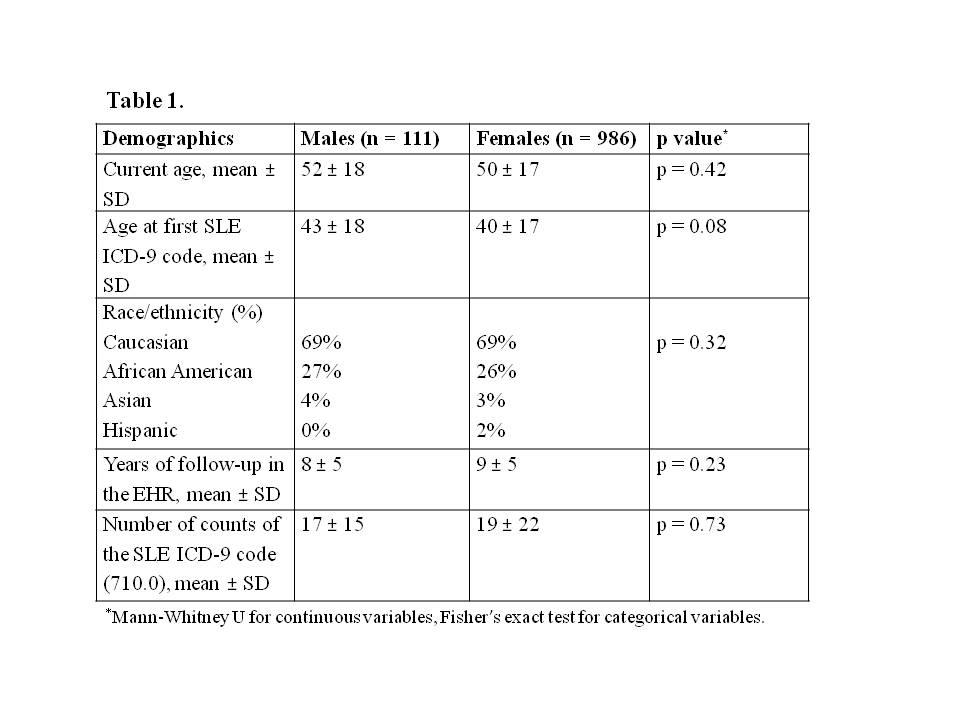Session Information
Session Type: ACR Poster Session B
Session Time: 9:00AM-11:00AM
Background/Purpose: Systemic lupus erythematosus (SLE) has a female to male ratio of 9:1. While SLE is more prevalent in females, males with SLE may have increased disease severity and mortality. Mechanisms for these outcomes are not known, as males are often understudied. We assessed differences in comorbidities in males vs. females by performing the first electronic health record (EHR)-based phenome-wide association study (PheWAS) in SLE. Similar to genome-wide association studies, PheWAS compare two groups using ICD-9 codes in place of single nucleotide polymorphisms.
Methods: We used our validated algorithm of ≥ 4 counts of the SLE ICD-9 code (710.0) and ANA positive > 1:160 while excluding dermatomyositis and systemic sclerosis ICD-9 codes to identify SLE cases in a de-identified EHR called the Synthetic Derivative (SD). The SD contains over 2.5 million subjects with clinical data collected longitudinally over several decades. Our algorithm has an internally validated positive predictive value of 94% and a sensitivity of 86%. PheWAS was performed in males vs. females adjusting for race and current age in logistic regression models and correcting for multiple testing using Bonferroni.
Results: We identified 986 females and 111 males with SLE. Males and females had similar mean current age, age at first SLE ICD-9 code, race breakdown, mean years of follow-up, and number of SLE code counts (Table 1). Adjusting for race and current age, males were more likely to have cardiac codes vs. females including atrial fibrillation odds ratio (OR) = 4.50 (95% CI 2.32 – 8.72), p = 8.6 x 10-6, other chronic ischemic heart disease OR = 4.40 (2.24 – 8.64), p = 1.7 x 10-5, atrial fibrillation and flutter OR = 4.08 (2.12 – 7.83), p = 2.4 x 10-5, and coronary atherosclerosis OR = 3.34 (95% CI 1.87 – 5.97), p = 4.56 x 10-5 (Figure 1). These four codes met the Bonferroni threshold for significance (p < 1.26 x 10-4). There were 51 SLE patients with the atrial fibrillation code, who were all confirmed on chart review. Males and females with atrial fibrillation had similar race breakdown, mean current age, and age at first SLE and atrial fibrillation codes.
Conclusion : These findings demonstrate the ability of PheWAS to uncover novel phenotype associations within a disease. While there is a 5-fold increased risk of cardiovascular disease overall in SLE, the increased relative risk of atrial fibrillation in males vs. females with SLE has not been identified. The odds of atrial fibrillation are two times higher in males in the general population; however, our data show a more pronounced sex difference in SLE patients.
To cite this abstract in AMA style:
Barnado A, Carroll R, Casey C, Denny JC, Crofford LJ. Phenome-Wide Association Study Identifies a New Association of Atrial Fibrillation in Males with Systemic Lupus Erythematosus [abstract]. Arthritis Rheumatol. 2016; 68 (suppl 10). https://acrabstracts.org/abstract/phenome-wide-association-study-identifies-a-new-association-of-atrial-fibrillation-in-males-with-systemic-lupus-erythematosus/. Accessed .« Back to 2016 ACR/ARHP Annual Meeting
ACR Meeting Abstracts - https://acrabstracts.org/abstract/phenome-wide-association-study-identifies-a-new-association-of-atrial-fibrillation-in-males-with-systemic-lupus-erythematosus/


